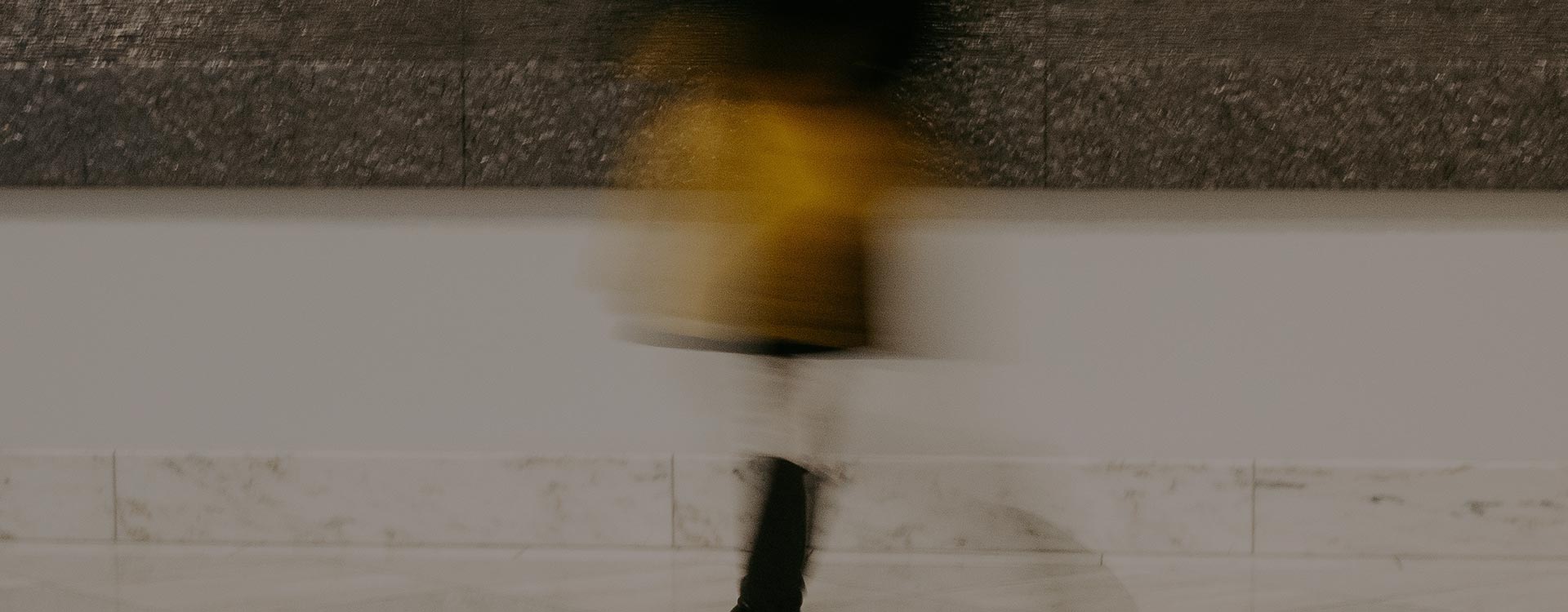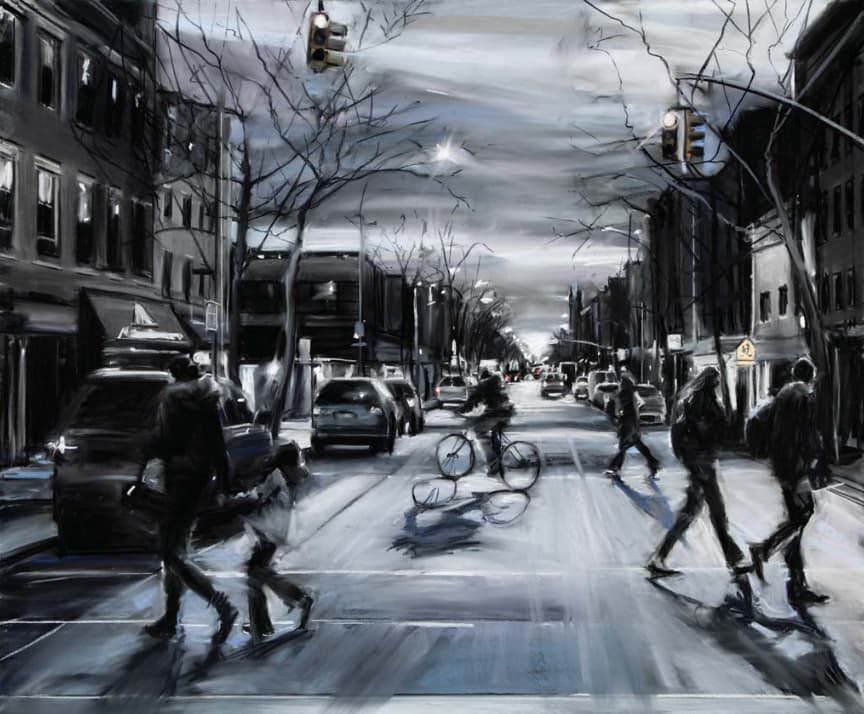
Charcoal Drawings
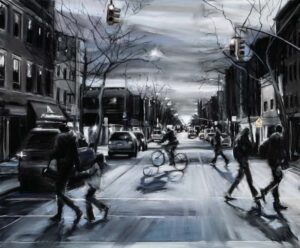
How did the city become your main subject? Have you always been fascinated with urban spaces?
I’ve been fascinated with them since I moved to New York — wherever I am is sort of what I draw. Because I’ve been in New York City for a long time I know it well, and I use it in many ways as a metaphor, as we all do. It’s my muse, I could say. And since I know it well I don’t have to work as hard to find the imagery. I know what I’m looking for, and I just shoot images. I then use several images to make one drawing I don’t work out of one specific photograph.
What are some of the things you’re looking for when taking photographs?
Usually a time of day or a type of weather. For instance, I like nocturnal scenes, and I like when it’s raining or blustery out. Eight o’clock in the morning in the fall has beautiful shadows. It’s as simple as that. In many ways, it’s a formal need. I surprise myself when I develop these photos into charcoal drawings. In some ways, these moments are kind of banal, but when I draw them and blow them up, those banal moments become something quite different, and it becomes an interesting narrative.
In your drawings, the city is always alive, filled with people. Do you think this is essential to the look of a city?
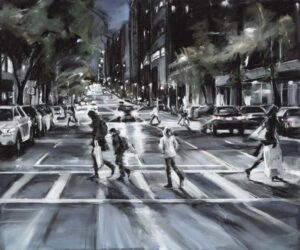
I don’t think I’ve ever done a New York City piece without people in it, although as some observers have noticed there are no faces in my drawings — I don’t want the viewer locked in on a person’s eyes. I like to use the figure in an almost iconic way. A woman whose head is bent carrying a bag or a child running a certain way. We know who they are, I hope, from how they move and from recognizing our own gestures.
How did you come to work primarily in drawing? And what about your combination of charcoal drawings and pastel?
What I love about drawing is that we’ve all done it. As little kids, we pick up a pencil or a piece of chalk and we draw. It isn’t precious. I can spend the time creating these objects, but I love that everyone can relate to them. I also love that the sweep of my hand can change the image. There’s movement in drawing for me, there’s a physicality to it, and the gesture of my hand is always involved. As for the charcoal and pastel, over time I’ve been able to work them almost like paint. I love the notion of painterly drawing.
What do you like about working big?
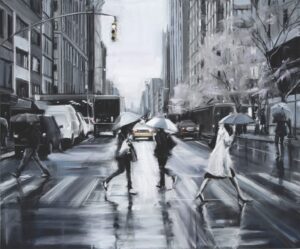
I think it started because historically, drawings and works on paper have been thought of as studies and as a certain size. So one reason is the idea of taking a drawing and blowing it up so that it’s a work unto itself so that people don’t see it as a drawing but as a work of art comparable to painting. A second reason is that there’s a different drama to a piece when it’s large when it’s physical. A large drawing invites the viewer into a very different world. This isn’t to say I don’t love intimate drawings, but large is where I’m more comfortable. And going large lets me get physical. I love using my body to create the image.
Do you do sketching or preliminary work or dive right in?
I dive right in. When I say that there’s no preciousness, I mean it, and that’s what I love about drawing. If I think something is not going somewhere, I rip it up and throw it away, and that allows me freedom.
My process starts with taking photographs. Then I go to a pharmacy and have maybe 100 of them printed. I take those to my studio and find things in some of the photos that excite me, and I pin 10 or so of them up on my studio wall. Suppose I want to make three 50-x-60 drawings. I put those three boards up. I put in my earbuds, turn on the music, and I just start.
That’s not to say it will all work. The next day I might come in and scrap what I’ve done. If my photographs aren’t allowing me to find a storyline, I’ll go get more photos. I’ll change it.
Tell us more about your process. How do you begin your charcoal drawings?
I like to do a very fast drawings. I will get everything in, at least initially, in about a five-hour period. Then I like to bring it together all at once, not to finish one part at a time.
I begin by putting in what I call my “stage setting,” or my environment. If I’m drawing a view of Lexington Avenue, that stage setting will stay the same, but I’ll keep changing the people in it until they work for me. The color just happens. It works itself in during the process. I don’t plan that, but I do like to have an allover sense of composition on the paper. It’s more of an abstract expressionist way of taking in the whole paper — not the apple first, then the vase, then the table.
What’s in your toolkit?
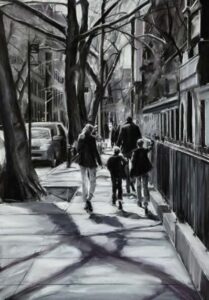
For charcoal drawings, I use jumbo soft dark charcoal that I get at New York Central Art Supply. Eventually, those charcoals form sort of underpainting. The pastels I love most are Diane Townsend. I order them straight from her; they’re glorious. Also, I use some Sennelier pastels, the jumbo ones. I can’t work with small drawing implements I use my fingers a lot, but I can’t get tied down in little movements or sharp tools.
My surface used to simply be paper, but the large pieces were difficult to frame, so now I work on paper mounted to board. I also spray the drawings a lot, which lets me build up the layers. If you take a paper towel and rub a highlight out, then spray it and put a white back on, it’s more luminous.
Did you have influential teachers?
I studied at Bennington College, which had an incredible art world that I became immersed in. I got my master’s degree at Brooklyn College, where Lois Dodd and Leonard Anderson taught. From Bennington to Brooklyn I was fortunate to have extraordinary artists guide the way I thought and teach me a new language, a new way of thinking.
Getting out of graduate school I was lucky to have people interested in my work. I was mostly painting then, but I had some drawings sitting in a corner of my studio, and Rick Davidman, who ran DFN Gallery, in Chelsea, saw them and said “Those are good drawings!” I realized there were better painters out there, and drawing came easier to me. Why force yourself to do something that’s more difficult? I don’t want any more barriers.
What’s your advice for young artists or for someone wanting to get serious about drawing?
I’m a great believer in artists going to graduate school. You get a studio, a place to work, and you connect with other artists. It’s very important to get criticism. There’s a language to learn. I also think you have to have an absolute passion for this thing. There’s business and creativity, and they have to go together. And then? Go for it. It’s tough.
artistsnetwork.com

